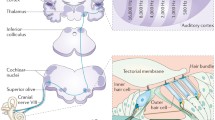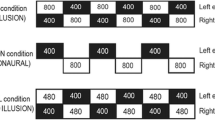Abstract
The phantom sound perception mechanism by which a sound perception occurs without any external sound source is still enigmatic. According to our previous fMRI study, a small region in the parietal operculum 3 was hyperactivated as a function of tinnitus periodicity in subjects with acoustic trauma tinnitus sequelae. This region was localized in the vicinity of neural correlates of middle-ear tympano-ossicular chain movements due to pressure variations. Disturbed proprioceptors are known to trigger illusory perceptions; therefore, we hypothesized that a disturbance of middle-ear proprioceptors may originate phantom sound perceptions. We designed an fMRI study that aimed to stimulate middle-ear proprioceptors by repetitive vibrations using various rates of click trains. In this study, we report that exposure to specific rates of stimuli for a few minutes at comfortable intensity level in healthy subjects distinctly triggered transient tinnitus-like aftereffects. The fMRI neural correlates of the aftereffects were unequivocally localized in the same parietal region as in acoustic trauma tinnitus sufferers. Our results strongly suggest that a middle-ear kinesthetic/proprioceptive illusion exists at the origin of acoustic trauma tinnitus via a somatosensory pathway encompassing the trigeminal system.




Similar content being viewed by others
References
Ashburner J (2007) A fast diffeomorphic image registration algorithm. Neuroimage 38(1):95–113. doi:10.1016/j.neuroimage.2007.07.007
Babalian AL (2005) Synaptic influences of pontine nuclei on cochlear nucleus cells. Exp Brain Res 167(3):451–457. doi:10.1007/s00221-005-0178-8
Baguley D, McFerran D, Hall D (2013) Tinnitus. Lancet 382(9904):1600–1607. doi:10.1016/S0140-6736(13)60142-7
Burke D, Hagbarth KE, Lofstedt L, Wallin BG (1976) The responses of human muscle spindle endings to vibration of non-contracting muscles. J Physiol 261(3):673–693
Burton H, Sinclair RJ (2000) Tactile-spatial and cross-modal attention effects in the primary somatosensory cortical areas 3b and 1-2 of rhesus monkeys. Somatosens Mot Res 17(3):213–228
Burton H, Fabri M, Alloway K (1995) Cortical areas within the lateral sulcus connected to cutaneous representations in areas 3b and 1: a revised interpretation of the second somatosensory area in macaque monkeys. J Comp Neurol 355(4):539–562. doi:10.1002/cne.903550405
Coghill RC, Talbot JD, Evans AC, Meyer E, Gjedde A, Bushnell MC, Duncan GH (1994) Distributed processing of pain and vibration by the human brain. J Neurosci 14(7):4095–4108
Collins DF, Refshauge KM, Todd G, Gandevia SC (2005) Cutaneous receptors contribute to kinesthesia at the index finger, elbow, and knee. J Neurophysiol 94(3):1699–1706. doi:10.1152/jn.00191.2005
Da Costa S, van der Zwaag W, Marques JP, Frackowiak RS, Clarke S, Saenz M (2011) Human primary auditory cortex follows the shape of Heschl’s gyrus. J Neurosci 31(40):14067–14075. doi:10.1523/JNEUROSCI.2000-11.2011
Devlin JT, Raley J, Tunbridge E, Lanary K, Floyer-Lea A, Narain C, Cohen I, Behrens T, Jezzard P, Matthews PM, Moore DR (2003) Functional asymmetry for auditory processing in human primary auditory cortex. J Neurosci 23(37):11516–11522 pii: 23/37/11516
Disbrow E, Roberts T, Krubitzer L (2000) Somatotopic organization of cortical fields in the lateral sulcus of Homo sapiens: evidence for SII and PV. J Comp Neurol 418(1):1–21
Eickhoff SB, Schleicher A, Zilles K, Amunts K (2006) The human parietal operculum. I. Cytoarchitectonic mapping of subdivisions. Cereb Cortex 16(2):254–267. doi:10.1093/cercor/bhi105
Eickhoff SB, Grefkes C, Zilles K, Fink GR (2007) The somatotopic organization of cytoarchitectonic areas on the human parietal operculum. Cereb Cortex 17(8):1800–1811. doi:10.1093/cercor/bhl090
Eklund G (1972) General features of vibration-induced effects on balance. Ups J Med Sci 77(2):112–124
Goodwin GM, McCloskey DI, Matthews PB (1972) Proprioceptive illusions induced by muscle vibration: contribution by muscle spindles to perception? Science 175(4028):1382–1384
Grassi C, Deriu F, Passatore M (1993) Effect of sympathetic nervous system activation on the tonic vibration reflex in rabbit jaw closing muscles. J Physiol 469:601–613
Hugdahl K (2000) Lateralization of cognitive processes in the brain. Acta Psychol (Amst) 105(2–3):211–235
Itoh K, Kamiya H, Mitani A, Yasui Y, Takada M, Mizuno N (1987) Direct projections from the dorsal column nuclei and the spinal trigeminal nuclei to the cochlear nuclei in the cat. Brain Res 400(1):145–150 pii: 0006-8993(87)90662-7
Jain R, Shore S (2006) External inferior colliculus integrates trigeminal and acoustic information: unit responses to trigeminal nucleus and acoustic stimulation in the guinea pig. Neurosci Lett 395(1):71–75
Job A, Paucod J-C, O’Beirne GA, Delon-Martin C (2011) Cortical representation of tympanic membrane movements due to pressure variation: a fMRI study. Hum Brain Mapp 32:744–749
Job A, Pons Y, Lamalle L, Jaillard A, Buck K, Segebarth C, Delon-Martin C (2012) Abnormal cortical sensorimotor activity during “Target” sound detection in subjects with acute acoustic trauma sequelae: an fMRI study. Brain Behav 2(2):187–199. doi:10.1002/brb3.21
Kemp DT, Ryan S, Bray P (1990) A guide to the effective use of otoacoustic emissions. Ear Hear 11(2):93–105
Kierner AC, Zelenka I, Lukas JR, Aigner M, Mayr R (1999) Observations on the number, distribution and morphological peculiarities of muscle spindles in the tensor tympani and stapedius muscle of man. Hear Res 135(1–2):71–77 pii: S0378-5955(99)00092-1
Klein A, Andersson J, Ardekani BA, Ashburner J, Avants B, Chiang MC, Christensen GE, Collins DL, Gee J, Hellier P, Song JH, Jenkinson M, Lepage C, Rueckert D, Thompson P, Vercauteren T, Woods RP, Mann JJ, Parsey RV (2009) Evaluation of 14 nonlinear deformation algorithms applied to human brain MRI registration. Neuroimage 46(3):786–802. doi:10.1016/j.neuroimage.2008.12.037
Krubitzer L, Clarey J, Tweedale R, Elston G, Calford M (1995) A redefinition of somatosensory areas in the lateral sulcus of macaque monkeys. J Neurosci 15(5 Pt 2):3821–3839
Ledberg A, O’Sullivan BT, Kinomura S, Roland PE (1995) Somatosensory activations of the parietal operculum of man. A PET study. Eur J Neurosci 7(9):1934–1941
Matsuo R, Ikehara A, Nokubi T, Morimoto T (1995) Inhibitory effect of sympathetic stimulation on activities of masseter muscle spindles and the jaw jerk reflex in rats. J Physiol 483(Pt 1):239–250
Maudoux A, Lefebvre P, Cabay JE, Demertzi A, Vanhaudenhuyse A, Laureys S, Soddu A (2012) Auditory resting-state network connectivity in tinnitus: a functional MRI study. PLoS One 7(5):e36222. doi:10.1371/journal.pone.0036222
Mazzola L, Faillenot I, Barral FG, Mauguiere F, Peyron R (2012) Spatial segregation of somato-sensory and pain activations in the human operculo-insular cortex. Neuroimage 60(1):409–418. doi:10.1016/j.neuroimage.2011.12.072
Naito E, Ehrsson HH, Geyer S, Zilles K, Roland PE (1999) Illusory arm movements activate cortical motor areas: a positron emission tomography study. J Neurosci 19(14):6134–6144
Passatore M, Deriu F, Grassi C, Roatta S (1996) A comparative study of changes operated by sympathetic nervous system activation on spindle afferent discharge and on tonic vibration reflex in rabbit jaw muscles. J Auton Nerv Syst 57(3):163–167 pii: 0165183895000747
Pilati N, Ison MJ, Barker M, Mulheran M, Large CH, Forsythe ID, Matthias J, Hamann M (2012) Mechanisms contributing to central excitability changes during hearing loss. Proc Natl Acad Sci USA 109(21):8292–8297. doi:10.1073/pnas.1116981109
Proske U, Gandevia SC (2009) The kinaesthetic senses. J Physiol 587(Pt 17):4139–4146. doi:10.1113/jphysiol.2009.175372
Roatta S, Windhorst U, Ljubisavljevic M, Johansson H, Passatore M (2002) Sympathetic modulation of muscle spindle afferent sensitivity to stretch in rabbit jaw closing muscles. J Physiol 540(Pt 1):237–248 pii:PHY_14316
Roll JP, Vedel JP (1982) Kinaesthetic role of muscle afferents in man, studied by tendon vibration and microneurography. Exp Brain Res 47(2):177–190
Roll JP, Vedel JP, Ribot E (1989) Alteration of proprioceptive messages induced by tendon vibration in man: a microneurographic study. Exp Brain Res 76(1):213–222
Rosenblith WA, Miller GA, Egan JP, Hirsh IJ, Thomas GJ (1947) An auditory afterimage? Science 106(2754):333–335. doi:10.1126/science.106.2754.333
Shore SE, Vass Z, Wys NL, Altschuler RA (2000) Trigeminal ganglion innervates the auditory brainstem. J Comp Neurol 419(3):271–285
Taylor A, Ellaway PH, Durbaba R (1999) Why are there three types of intrafusal muscle fibers? Prog Brain Res 123:121–131
Vanneste S, De Ridder D (2013) Brain areas controlling heart rate variability in tinnitus and tinnitus-related distress. PLoS One 8(3):e59728. doi:10.1371/journal.pone.0059728
Vass Z, Shore SE, Nuttall AL, Miller JM (1998) Direct evidence of trigeminal innervation of the cochlear blood vessels. Neuroscience 84(2):559–567 pii: S0306-4522(97)00503-4
Weerakkody NS, Mahns DA, Taylor JL, Gandevia SC (2007) Impairment of human proprioception by high-frequency cutaneous vibration. J Physiol 581(Pt 3):971–980. doi:10.1113/jphysiol.2006.126854
Westcott M, Sanchez TG, Diges I, Saba C, Dineen R, McNeill C, Chiam A, O’Keefe M, Sharples T (2013) Tonic tensor tympani syndrome in tinnitus and hyperacusis patients: a multi-clinic prevalence study. Noise Health 15(63):117–128. doi:10.4103/1463-1741.110295
Zhou J, Shore S (2004) Projections from the trigeminal nuclear complex to the cochlear nuclei: a retrograde and anterograde tracing study in the guinea pig. J Neurosci Res 78(6):901–907. doi:10.1002/jnr.20343
Acknowledgments
We are grateful to Alain Roux and Hervé Mathieu for their technical assistance and the NATO group HFM-229 for their precious advises. This work was supported by Grants from Délégation Générale de l’Armement (DGA) under number 11 CA 801 (to A. J.). We thank the Grenoble MRI facility, partially funded by the French national program “Investissement d’Avenir” run by the ‘Agence Nationale pour la Recherche’ Grant No- ANR-11-INBS-0006.
Conflict of interest
The authors declare no competing financial interest.
Author information
Authors and Affiliations
Corresponding author
Electronic supplementary material
Below is the link to the electronic supplementary material.
Rights and permissions
About this article
Cite this article
Job, A., Jacob, R., Pons, Y. et al. Specific activation of operculum 3 (OP3) brain region during provoked tinnitus-related phantom auditory perceptions in humans. Brain Struct Funct 221, 913–922 (2016). https://doi.org/10.1007/s00429-014-0944-0
Received:
Accepted:
Published:
Issue Date:
DOI: https://doi.org/10.1007/s00429-014-0944-0




